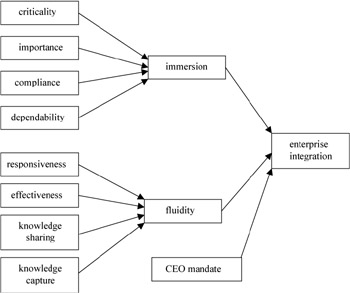Discussion and Conclusions
|
| < Day Day Up > |
|
Consistent with the inductive nature of phenomenological research, theory should emerge from the analysis of the data with the end goal of gaining an emic perspective. Chikudate (1999) uses the term essence when referring to an emic perspective. The research attempted to understand David's construction of reality from the interviews so that we can begin theorizing on the factors influencing enterprise integration and the role that BPR and HPT play.
Since enterprise integration was the end goal of top management, the de facto dependent variable is enterprise integration. The reasoning behind adopting HPT in the first place was to better integrate the enterprise in terms of information sharing, reporting, standardization, and effective processes. Analysis of the data revealed many factors (independent variables) that influence, positively or negatively, the ability of HPT and BPR to accomplish this goal.
From our analysis, we were able to classify the themes into immersion, fluidity, and top management support or mandate. Technology usage and HPT adoption reveal that Vicro Communications is immersed in technology, that is, they depend on technology to do their work. Process improvement reveals that Vicro is attempting to become a more fluid organization, that is, they want information to flow freely so that it can be shared, seamless processes that effectively support business activities can be created, and they can delight their customers. CEO mandates reveal that top management was concerned with fluidity and immersion issues and wanted to do something about it. Although their choice of HPT appears to be misguided, they realized that change must be supported from the top. Resistance to change reveals that fluidity and CEO mandates are inextricably tied to how people perceive change. Process improvement is accomplished through people at the process level who do the work. They therefore need the resources and support of management to engineer and redesign processes.
Factors that emerge from the data related to immersion include criticality, importance, compliance, and dependability. Vicro Communications is immersed in technology because people need them do to their work, that is, technology is critical and important. Technology also enables people to comply with work demands. For instance, if an ad hoc report is required within two hours, the use of technology (databases, networks, computer terminals, and printers) allows people to comply with demands.
Factors that emerge from the data related to fluidity include responsiveness, effectiveness, knowledge sharing, and knowledge capture. The objective of process improvement is to improve responsiveness to customers by designing and redesigning effective processes. To improve responsiveness to customers processes must enable effective knowledge sharing and capture, reduce unnecessary costs, and save time. In addition, enterprise systems must work in alignment with business processes. Database technology, networks, software, operating systems, and desktops are the main technology components in a business. Each of these components needs to be streamlined in a seamless manner, that is, desktops should be able to talk to databases through networks without concern for hardware, software, and operating system platforms.
Vicro Communications made no attempt to analyze existing processes and systems to see if they were fluid. They are immersed in technology, but fluidity is a major obstacle and probably the major reason for the failure of HPT. Without the theory that emerged from this study, we would have no baseline to determine the root problems at Vicro. Figure 7 graphically illustrates our initial theory as we begin to gain an emic perspective of the case. Conducting more in-depth interviews and analysis can refine our theory.

Figure 7: Emergent theoretical model
|
| < Day Day Up > |
|
EAN: 2147483647
Pages: 174